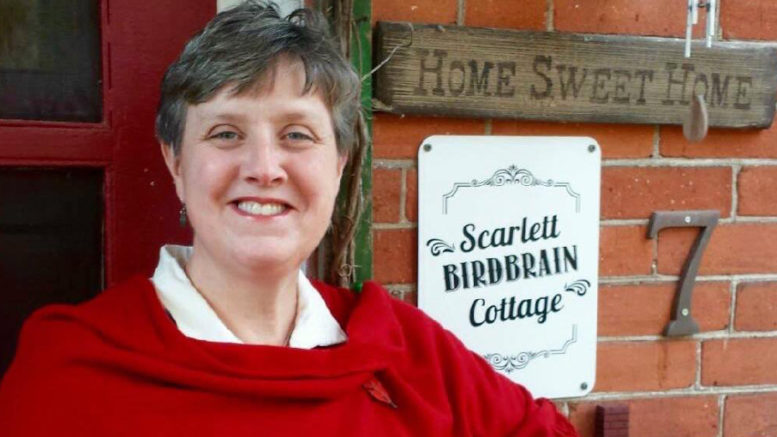Laurie Snider
Notes from the Nest
The inside of the large banquet hall at the Strathcona Paper Centre was awash in colour. In every direction in my sight line were rich hues, eye-catching innovative designs and an extensive variety of fabrics sewn together, displaying everything from traditional to razzle dazzle compositions. Generous full-sized bed-toppers were suspended from the ceiling, beside modest artistic pieces with smaller, striking wall-hangings affixed to the surrounding surfaces. This year’s edition of The Napanee Heritage Quilt Show was an absolute feast to behold.
Quilts are essentially fabric sandwiches with two layers of material, a bottom and a top, with a sheet of batting between the two as filling, all sewn together. Some of the earliest examples of quilting are from the 12th Century, when the Crusaders wore quilted garments called gambesons under their armour to stay toasty and protected. One of the earliest quilts discovered is the Tristan quilt, made in 1360. Two sections of it are housed in museums, in London and France.
Quilt making arrived in North America with the earliest settlers. Originally only the wealthy had time to quilt. These were frequently decorative pieces, displaying their fine needlework. Most other women were busy spinning, weaving and making clothes for their families. Eventually, as fabric was manufactured women had more free time to make quilts.
Mostly quilts were made as bed-coverings using every scrap of left-over fabric, including worn-out garments and remnants of clothes. Quilts were also used as coverings for doors and windows, to help keep out the cold. During the time of the Underground Railroad, regularly a log cabin quilt would be hung outside a home, as a signal that it was safe for runaway slaves.
Quilts today are still used commonly as the top cover on beds but many are also superbly constructed, stunning show pieces well deserving of honors and accolades. While some of these masterworks continue to be hand quilted, many are now done with the aid of specialty sewing machines capable of intricate designs.
The chairwoman of the show, Amy Tompkins, and the president of the guild, Sheila Lucas — both lovely ladies — were kind enough to show my daughter Ellie and I around as we took in the show’s highlights. It was exceedingly impressive. Over 70 quilts and wall-hangings, as well as 40 special projects, were being exhibited. The Quilt show occurs every other year and Amy told me it takes a full two years to plan and come together. Close to 1,000 people attended this year’s offering.
The guild meets once a month from September to June where they have draws, show and tell sessions, trunk shows and a potluck. Sounds like fun to me. The Farm House Quilters are also part of the Guild and also meet monthly. Together they produce many quilts, donating them to worthy causes including Nursing home patients, neo-natal intensive care unit, refugee families, after disasters like a fire, Habitat for Humanity families and to members of Northern communities to name a few. The ladies shared, basically if someone is in need, we will make a quilt for them. Heartwarming!
Earlier in the weekend, I paid a visit to a friend who earns her living as an artist making quilts. Annette Willis of Chasing Lightning Bugs Studio in Kingston’s Portsmouth Village is an enchanting, kind, remarkably accomplished, creative visionary. She grew up on a farm north-west of the city and spent time in both the U.S. and Paris in her early adult years. She and her husband live in a comfortable, bucolic, rustic limestone home and the small, clapboard house next door to it serves as her studio. She came up with the name, after watching her husband Tom and a young guest catch lightning bugs in their yard. She said, “it encapsulated the simple life and all of the joy it represents.”
She has also named her quilting machine, ‘Hilda’, as she explained, “it sounded like a hard-working woman’s name.” Annette is a multi-talented artist who also paints, sews, makes collages and writes. She inspires me. She’s never taken a quilting class. She decided to take it up in 2004, after watching a scene in a movie where a quilt was being thrown up into the air.
The following day she borrowed her Aunt’s sewing machine, made a quilt and hasn’t looked back since. She makes over 65 quilts per year and says she has no trouble selling them. They are frequently given as gifts, including for some well-known clients aware of her outstanding capabilities. She confessed to me, “I love it! I have no rules or restrictions.” What could be better?
What a delightful, engaging weekend I had immersed in the quilting universe but now I think it’s time to go snuggle under mine. I believe I could use a little nap.

